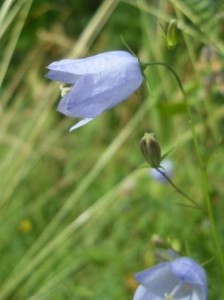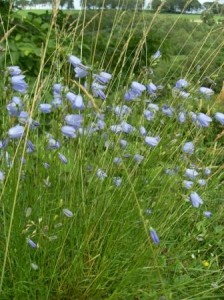Fairy flower
Campanula rotundifolia is most commonly referred to as the Scottish bluebell or harebell.
These flowers are a favourite with many people and deservedly so. Their delicate papery flowers nod happily in a breeze. They are often found in large clumps, adding a lovely splash of light blue to a meadow or woodland.

As they flower from July to September, they are out long after many of our wildflowers so really make an impact. They also provide a late source of nectar for bees.
But it’s not just the wildlife and people that enjoy harebells. Fairy folk and witches are strongly associated with these flowers in folklore. A patch of harebells is a favourite home for fairies and if one is to walk through such a clump, the fairies cast spells on the perpetrator, giving this flower the names of Dead Man’s Bells and Fairies’ thimbles.

It was a strong belief that witches could turn in to hares to avoid detection. Many believed this flower was used in the spell to transform them. Others thought the juice of a crushed flower was used in the spell to make them fly.
Bye for now,
Rhian (Seasonal Ranger)
Help protect Scotland’s wildlife
Our work to save Scotland’s wildlife is made possible thanks to the generosity of our members and supporters.
Join today from just £3 a month to help protect the species you love.
Preface
Campanula rotundifolia is most commonly referred to as the Scottish bluebell or harebell. These flowers are a favourite with many people and deservedly so. Their delicate papery flowers nod happily …
